Exploring Feminist Literary Criticism in Atwood's The Handmaid's Tale
VerifiedAdded on 2019/11/12
|7
|1483
|126
Essay
AI Summary
This essay provides a detailed analysis of Margaret Atwood's The Handmaid's Tale, focusing on the interplay of gender roles, feminist literary criticism, and queer theory within the dystopian narrative. The essay examines how the novel critiques the subjugation of women and the suppression of non-normative sexual identities in the patriarchal regime of Gilead. It explores themes of objectification, reproductive control, and the denial of individual identities, highlighting the importance of feminist and queer perspectives in understanding the novel's complex social commentary. Furthermore, the essay considers the intersection of gender, race, and class, discussing the limitations of the novel's focus on white feminism and its relative neglect of the experiences of women of color. The analysis draws on literary theories and critical perspectives to illuminate the novel's enduring relevance in contemporary discussions of gender, power, and social justice.
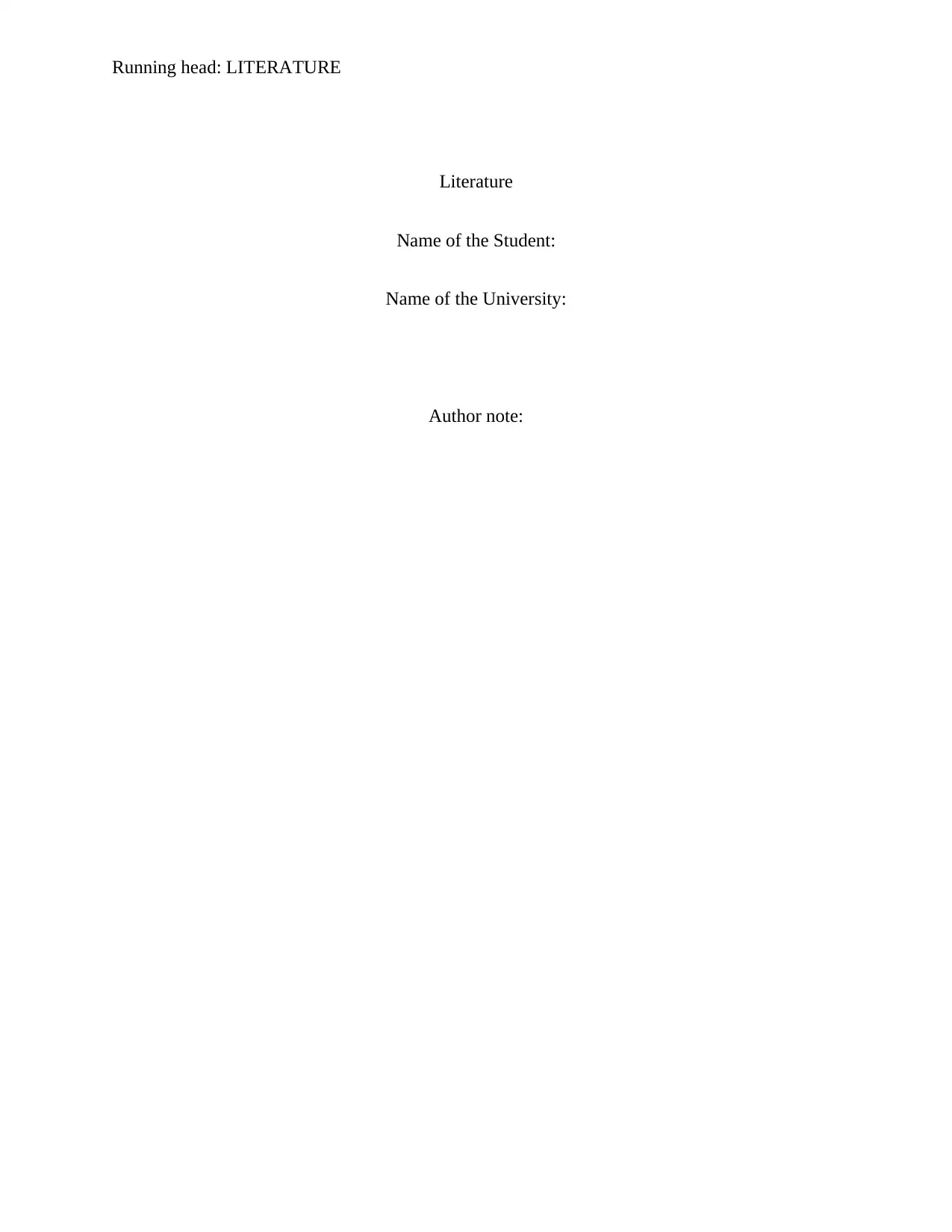
Running head: LITERATURE
Literature
Name of the Student:
Name of the University:
Author note:
Literature
Name of the Student:
Name of the University:
Author note:
Paraphrase This Document
Need a fresh take? Get an instant paraphrase of this document with our AI Paraphraser
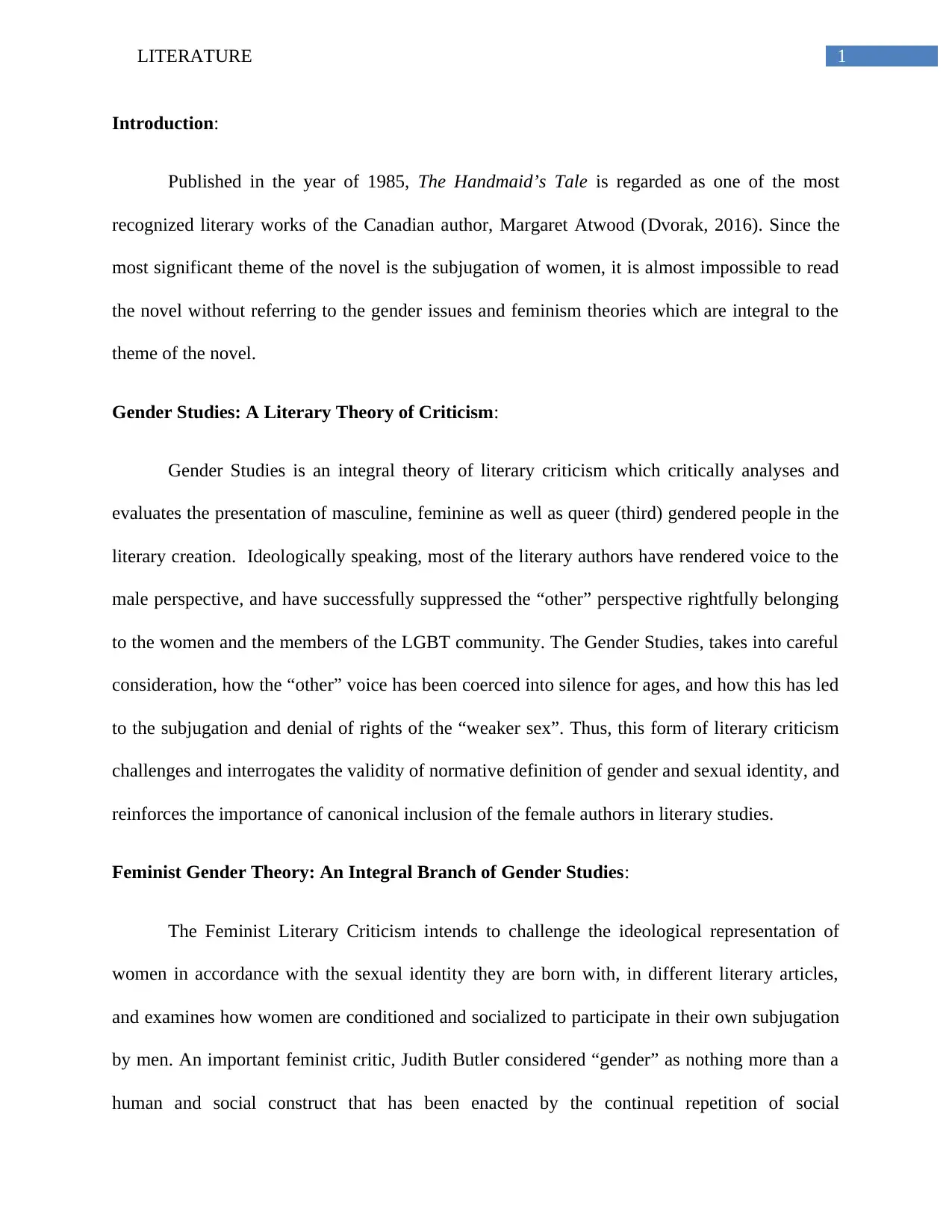
1LITERATURE
Introduction:
Published in the year of 1985, The Handmaid’s Tale is regarded as one of the most
recognized literary works of the Canadian author, Margaret Atwood (Dvorak, 2016). Since the
most significant theme of the novel is the subjugation of women, it is almost impossible to read
the novel without referring to the gender issues and feminism theories which are integral to the
theme of the novel.
Gender Studies: A Literary Theory of Criticism:
Gender Studies is an integral theory of literary criticism which critically analyses and
evaluates the presentation of masculine, feminine as well as queer (third) gendered people in the
literary creation. Ideologically speaking, most of the literary authors have rendered voice to the
male perspective, and have successfully suppressed the “other” perspective rightfully belonging
to the women and the members of the LGBT community. The Gender Studies, takes into careful
consideration, how the “other” voice has been coerced into silence for ages, and how this has led
to the subjugation and denial of rights of the “weaker sex”. Thus, this form of literary criticism
challenges and interrogates the validity of normative definition of gender and sexual identity, and
reinforces the importance of canonical inclusion of the female authors in literary studies.
Feminist Gender Theory: An Integral Branch of Gender Studies:
The Feminist Literary Criticism intends to challenge the ideological representation of
women in accordance with the sexual identity they are born with, in different literary articles,
and examines how women are conditioned and socialized to participate in their own subjugation
by men. An important feminist critic, Judith Butler considered “gender” as nothing more than a
human and social construct that has been enacted by the continual repetition of social
Introduction:
Published in the year of 1985, The Handmaid’s Tale is regarded as one of the most
recognized literary works of the Canadian author, Margaret Atwood (Dvorak, 2016). Since the
most significant theme of the novel is the subjugation of women, it is almost impossible to read
the novel without referring to the gender issues and feminism theories which are integral to the
theme of the novel.
Gender Studies: A Literary Theory of Criticism:
Gender Studies is an integral theory of literary criticism which critically analyses and
evaluates the presentation of masculine, feminine as well as queer (third) gendered people in the
literary creation. Ideologically speaking, most of the literary authors have rendered voice to the
male perspective, and have successfully suppressed the “other” perspective rightfully belonging
to the women and the members of the LGBT community. The Gender Studies, takes into careful
consideration, how the “other” voice has been coerced into silence for ages, and how this has led
to the subjugation and denial of rights of the “weaker sex”. Thus, this form of literary criticism
challenges and interrogates the validity of normative definition of gender and sexual identity, and
reinforces the importance of canonical inclusion of the female authors in literary studies.
Feminist Gender Theory: An Integral Branch of Gender Studies:
The Feminist Literary Criticism intends to challenge the ideological representation of
women in accordance with the sexual identity they are born with, in different literary articles,
and examines how women are conditioned and socialized to participate in their own subjugation
by men. An important feminist critic, Judith Butler considered “gender” as nothing more than a
human and social construct that has been enacted by the continual repetition of social
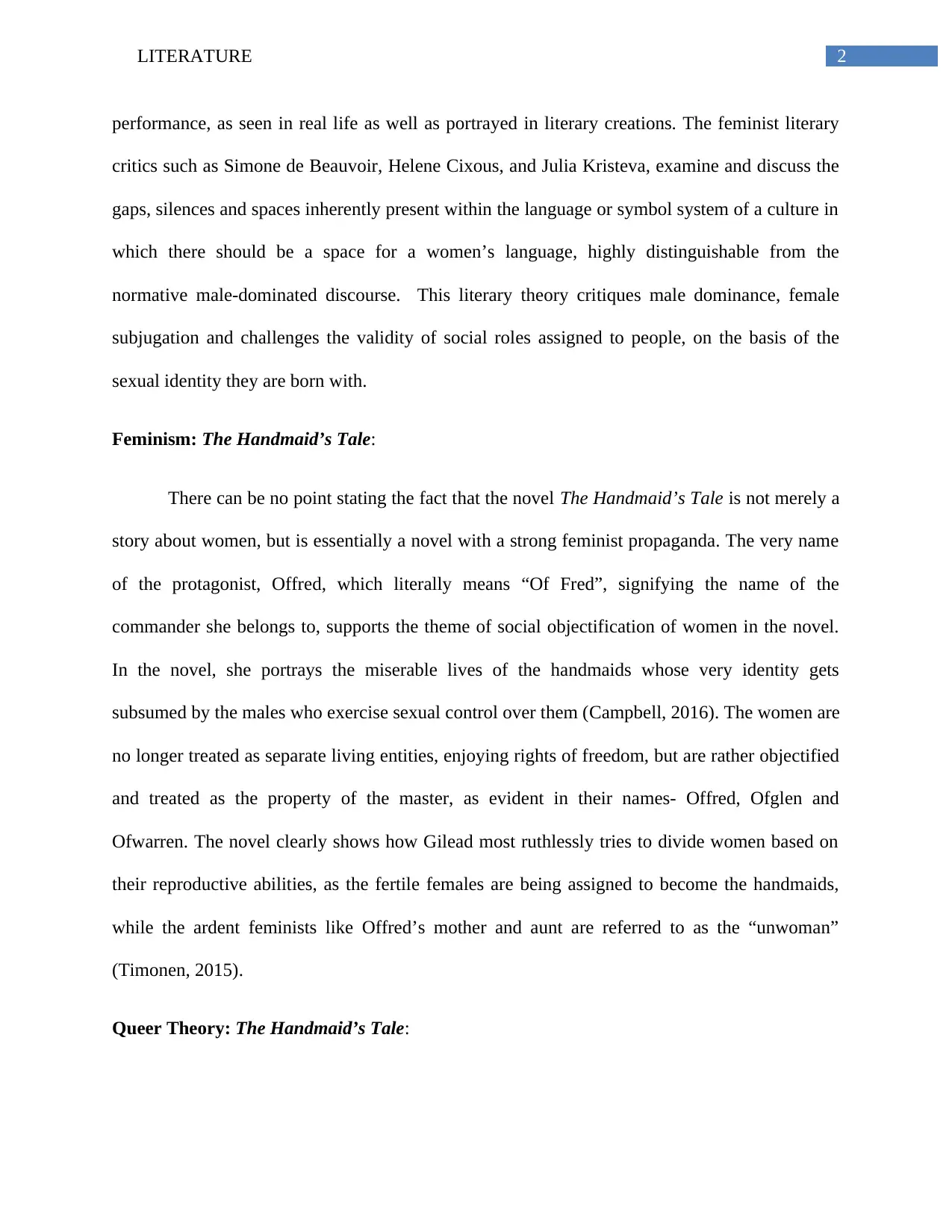
2LITERATURE
performance, as seen in real life as well as portrayed in literary creations. The feminist literary
critics such as Simone de Beauvoir, Helene Cixous, and Julia Kristeva, examine and discuss the
gaps, silences and spaces inherently present within the language or symbol system of a culture in
which there should be a space for a women’s language, highly distinguishable from the
normative male-dominated discourse. This literary theory critiques male dominance, female
subjugation and challenges the validity of social roles assigned to people, on the basis of the
sexual identity they are born with.
Feminism: The Handmaid’s Tale:
There can be no point stating the fact that the novel The Handmaid’s Tale is not merely a
story about women, but is essentially a novel with a strong feminist propaganda. The very name
of the protagonist, Offred, which literally means “Of Fred”, signifying the name of the
commander she belongs to, supports the theme of social objectification of women in the novel.
In the novel, she portrays the miserable lives of the handmaids whose very identity gets
subsumed by the males who exercise sexual control over them (Campbell, 2016). The women are
no longer treated as separate living entities, enjoying rights of freedom, but are rather objectified
and treated as the property of the master, as evident in their names- Offred, Ofglen and
Ofwarren. The novel clearly shows how Gilead most ruthlessly tries to divide women based on
their reproductive abilities, as the fertile females are being assigned to become the handmaids,
while the ardent feminists like Offred’s mother and aunt are referred to as the “unwoman”
(Timonen, 2015).
Queer Theory: The Handmaid’s Tale:
performance, as seen in real life as well as portrayed in literary creations. The feminist literary
critics such as Simone de Beauvoir, Helene Cixous, and Julia Kristeva, examine and discuss the
gaps, silences and spaces inherently present within the language or symbol system of a culture in
which there should be a space for a women’s language, highly distinguishable from the
normative male-dominated discourse. This literary theory critiques male dominance, female
subjugation and challenges the validity of social roles assigned to people, on the basis of the
sexual identity they are born with.
Feminism: The Handmaid’s Tale:
There can be no point stating the fact that the novel The Handmaid’s Tale is not merely a
story about women, but is essentially a novel with a strong feminist propaganda. The very name
of the protagonist, Offred, which literally means “Of Fred”, signifying the name of the
commander she belongs to, supports the theme of social objectification of women in the novel.
In the novel, she portrays the miserable lives of the handmaids whose very identity gets
subsumed by the males who exercise sexual control over them (Campbell, 2016). The women are
no longer treated as separate living entities, enjoying rights of freedom, but are rather objectified
and treated as the property of the master, as evident in their names- Offred, Ofglen and
Ofwarren. The novel clearly shows how Gilead most ruthlessly tries to divide women based on
their reproductive abilities, as the fertile females are being assigned to become the handmaids,
while the ardent feminists like Offred’s mother and aunt are referred to as the “unwoman”
(Timonen, 2015).
Queer Theory: The Handmaid’s Tale:
⊘ This is a preview!⊘
Do you want full access?
Subscribe today to unlock all pages.

Trusted by 1+ million students worldwide
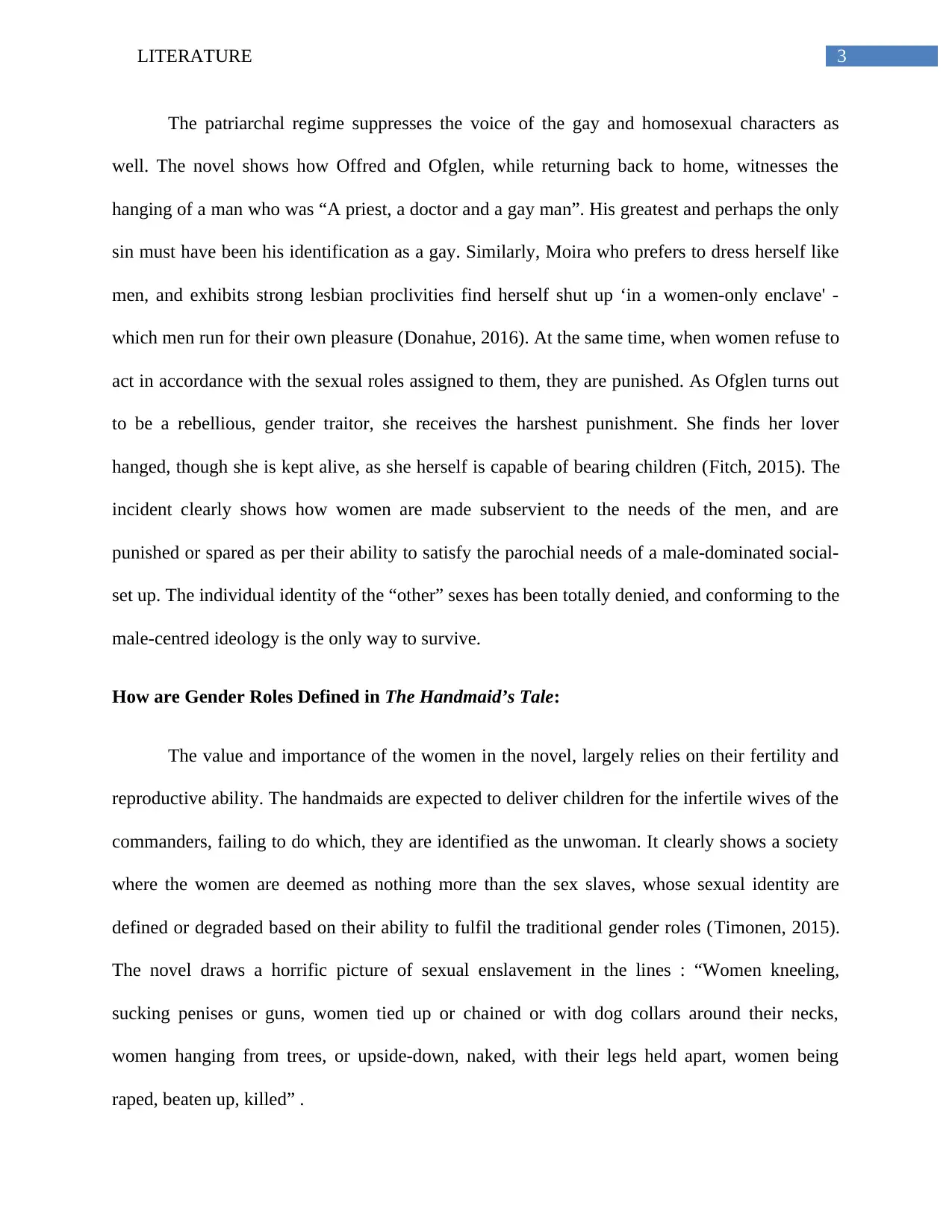
3LITERATURE
The patriarchal regime suppresses the voice of the gay and homosexual characters as
well. The novel shows how Offred and Ofglen, while returning back to home, witnesses the
hanging of a man who was “A priest, a doctor and a gay man”. His greatest and perhaps the only
sin must have been his identification as a gay. Similarly, Moira who prefers to dress herself like
men, and exhibits strong lesbian proclivities find herself shut up ‘in a women-only enclave' -
which men run for their own pleasure (Donahue, 2016). At the same time, when women refuse to
act in accordance with the sexual roles assigned to them, they are punished. As Ofglen turns out
to be a rebellious, gender traitor, she receives the harshest punishment. She finds her lover
hanged, though she is kept alive, as she herself is capable of bearing children (Fitch, 2015). The
incident clearly shows how women are made subservient to the needs of the men, and are
punished or spared as per their ability to satisfy the parochial needs of a male-dominated social-
set up. The individual identity of the “other” sexes has been totally denied, and conforming to the
male-centred ideology is the only way to survive.
How are Gender Roles Defined in The Handmaid’s Tale:
The value and importance of the women in the novel, largely relies on their fertility and
reproductive ability. The handmaids are expected to deliver children for the infertile wives of the
commanders, failing to do which, they are identified as the unwoman. It clearly shows a society
where the women are deemed as nothing more than the sex slaves, whose sexual identity are
defined or degraded based on their ability to fulfil the traditional gender roles (Timonen, 2015).
The novel draws a horrific picture of sexual enslavement in the lines : “Women kneeling,
sucking penises or guns, women tied up or chained or with dog collars around their necks,
women hanging from trees, or upside-down, naked, with their legs held apart, women being
raped, beaten up, killed” .
The patriarchal regime suppresses the voice of the gay and homosexual characters as
well. The novel shows how Offred and Ofglen, while returning back to home, witnesses the
hanging of a man who was “A priest, a doctor and a gay man”. His greatest and perhaps the only
sin must have been his identification as a gay. Similarly, Moira who prefers to dress herself like
men, and exhibits strong lesbian proclivities find herself shut up ‘in a women-only enclave' -
which men run for their own pleasure (Donahue, 2016). At the same time, when women refuse to
act in accordance with the sexual roles assigned to them, they are punished. As Ofglen turns out
to be a rebellious, gender traitor, she receives the harshest punishment. She finds her lover
hanged, though she is kept alive, as she herself is capable of bearing children (Fitch, 2015). The
incident clearly shows how women are made subservient to the needs of the men, and are
punished or spared as per their ability to satisfy the parochial needs of a male-dominated social-
set up. The individual identity of the “other” sexes has been totally denied, and conforming to the
male-centred ideology is the only way to survive.
How are Gender Roles Defined in The Handmaid’s Tale:
The value and importance of the women in the novel, largely relies on their fertility and
reproductive ability. The handmaids are expected to deliver children for the infertile wives of the
commanders, failing to do which, they are identified as the unwoman. It clearly shows a society
where the women are deemed as nothing more than the sex slaves, whose sexual identity are
defined or degraded based on their ability to fulfil the traditional gender roles (Timonen, 2015).
The novel draws a horrific picture of sexual enslavement in the lines : “Women kneeling,
sucking penises or guns, women tied up or chained or with dog collars around their necks,
women hanging from trees, or upside-down, naked, with their legs held apart, women being
raped, beaten up, killed” .
Paraphrase This Document
Need a fresh take? Get an instant paraphrase of this document with our AI Paraphraser
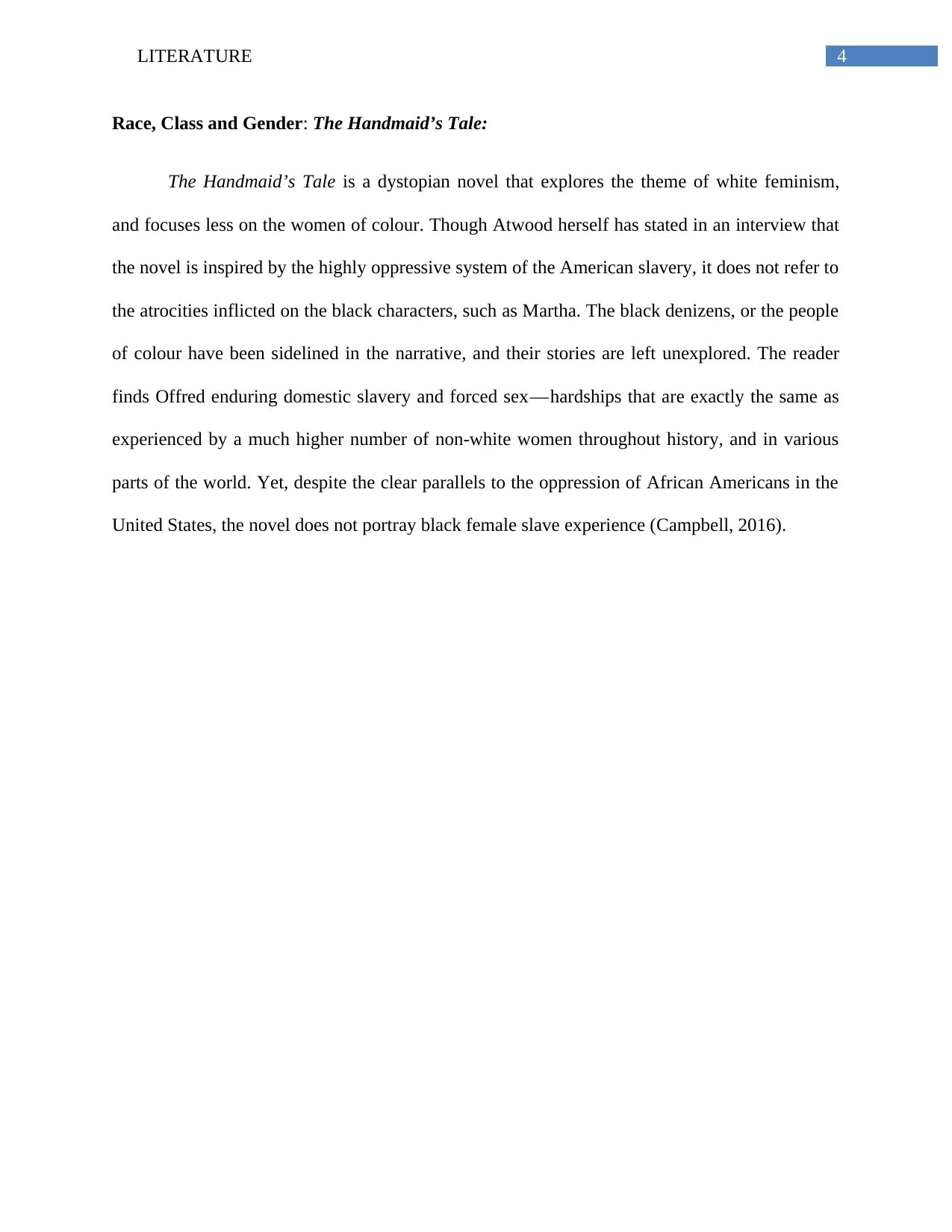
4LITERATURE
Race, Class and Gender: The Handmaid’s Tale:
The Handmaid’s Tale is a dystopian novel that explores the theme of white feminism,
and focuses less on the women of colour. Though Atwood herself has stated in an interview that
the novel is inspired by the highly oppressive system of the American slavery, it does not refer to
the atrocities inflicted on the black characters, such as Martha. The black denizens, or the people
of colour have been sidelined in the narrative, and their stories are left unexplored. The reader
finds Offred enduring domestic slavery and forced sex — hardships that are exactly the same as
experienced by a much higher number of non-white women throughout history, and in various
parts of the world. Yet, despite the clear parallels to the oppression of African Americans in the
United States, the novel does not portray black female slave experience (Campbell, 2016).
Race, Class and Gender: The Handmaid’s Tale:
The Handmaid’s Tale is a dystopian novel that explores the theme of white feminism,
and focuses less on the women of colour. Though Atwood herself has stated in an interview that
the novel is inspired by the highly oppressive system of the American slavery, it does not refer to
the atrocities inflicted on the black characters, such as Martha. The black denizens, or the people
of colour have been sidelined in the narrative, and their stories are left unexplored. The reader
finds Offred enduring domestic slavery and forced sex — hardships that are exactly the same as
experienced by a much higher number of non-white women throughout history, and in various
parts of the world. Yet, despite the clear parallels to the oppression of African Americans in the
United States, the novel does not portray black female slave experience (Campbell, 2016).
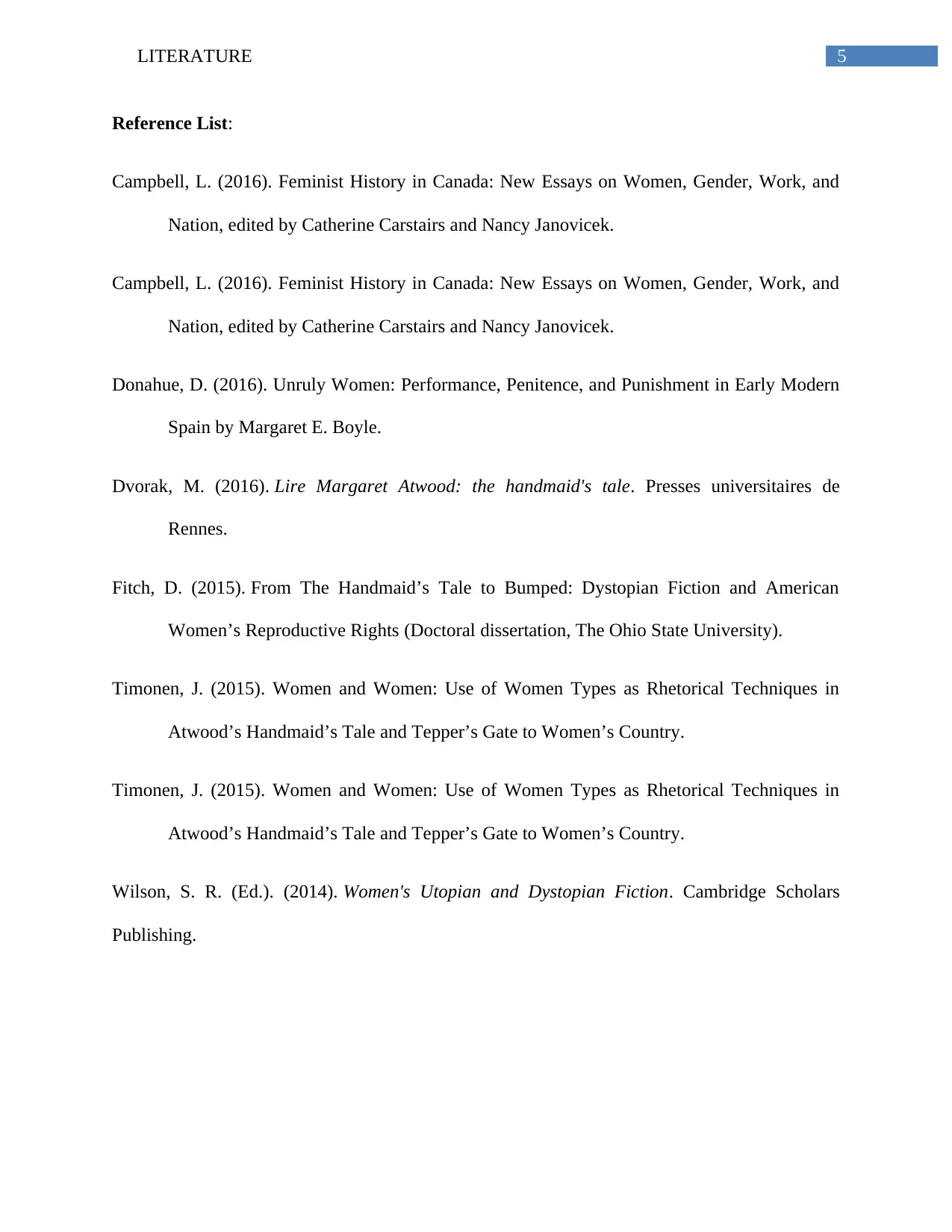
5LITERATURE
Reference List:
Campbell, L. (2016). Feminist History in Canada: New Essays on Women, Gender, Work, and
Nation, edited by Catherine Carstairs and Nancy Janovicek.
Campbell, L. (2016). Feminist History in Canada: New Essays on Women, Gender, Work, and
Nation, edited by Catherine Carstairs and Nancy Janovicek.
Donahue, D. (2016). Unruly Women: Performance, Penitence, and Punishment in Early Modern
Spain by Margaret E. Boyle.
Dvorak, M. (2016). Lire Margaret Atwood: the handmaid's tale. Presses universitaires de
Rennes.
Fitch, D. (2015). From The Handmaid’s Tale to Bumped: Dystopian Fiction and American
Women’s Reproductive Rights (Doctoral dissertation, The Ohio State University).
Timonen, J. (2015). Women and Women: Use of Women Types as Rhetorical Techniques in
Atwood’s Handmaid’s Tale and Tepper’s Gate to Women’s Country.
Timonen, J. (2015). Women and Women: Use of Women Types as Rhetorical Techniques in
Atwood’s Handmaid’s Tale and Tepper’s Gate to Women’s Country.
Wilson, S. R. (Ed.). (2014). Women's Utopian and Dystopian Fiction. Cambridge Scholars
Publishing.
Reference List:
Campbell, L. (2016). Feminist History in Canada: New Essays on Women, Gender, Work, and
Nation, edited by Catherine Carstairs and Nancy Janovicek.
Campbell, L. (2016). Feminist History in Canada: New Essays on Women, Gender, Work, and
Nation, edited by Catherine Carstairs and Nancy Janovicek.
Donahue, D. (2016). Unruly Women: Performance, Penitence, and Punishment in Early Modern
Spain by Margaret E. Boyle.
Dvorak, M. (2016). Lire Margaret Atwood: the handmaid's tale. Presses universitaires de
Rennes.
Fitch, D. (2015). From The Handmaid’s Tale to Bumped: Dystopian Fiction and American
Women’s Reproductive Rights (Doctoral dissertation, The Ohio State University).
Timonen, J. (2015). Women and Women: Use of Women Types as Rhetorical Techniques in
Atwood’s Handmaid’s Tale and Tepper’s Gate to Women’s Country.
Timonen, J. (2015). Women and Women: Use of Women Types as Rhetorical Techniques in
Atwood’s Handmaid’s Tale and Tepper’s Gate to Women’s Country.
Wilson, S. R. (Ed.). (2014). Women's Utopian and Dystopian Fiction. Cambridge Scholars
Publishing.
⊘ This is a preview!⊘
Do you want full access?
Subscribe today to unlock all pages.

Trusted by 1+ million students worldwide
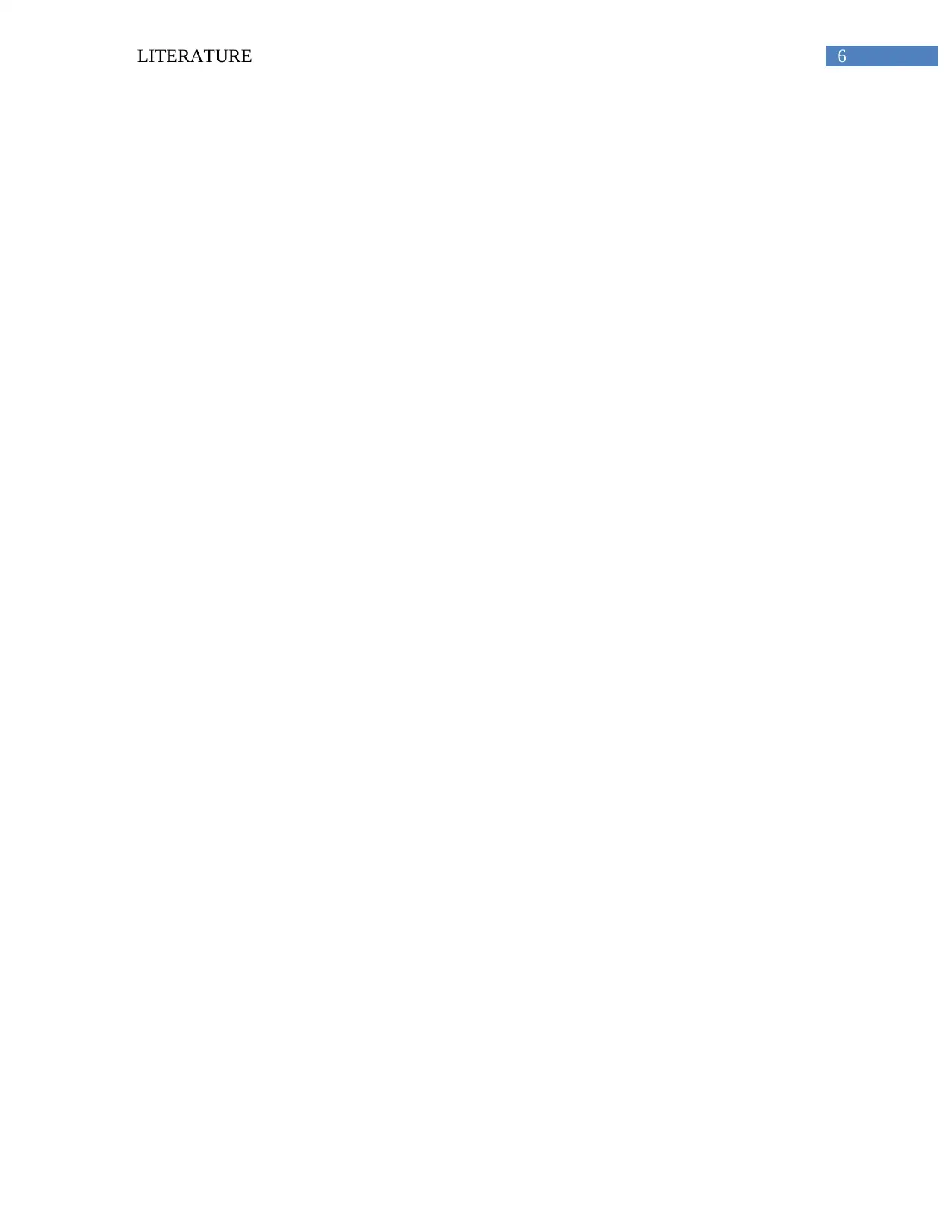
6LITERATURE
1 out of 7
Related Documents
Your All-in-One AI-Powered Toolkit for Academic Success.
+13062052269
info@desklib.com
Available 24*7 on WhatsApp / Email
![[object Object]](/_next/static/media/star-bottom.7253800d.svg)
Unlock your academic potential
Copyright © 2020–2025 A2Z Services. All Rights Reserved. Developed and managed by ZUCOL.





